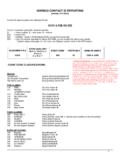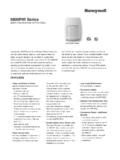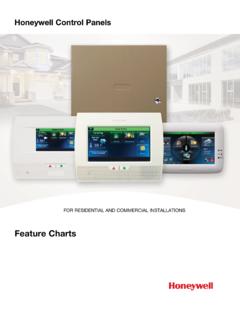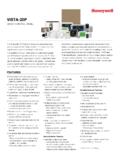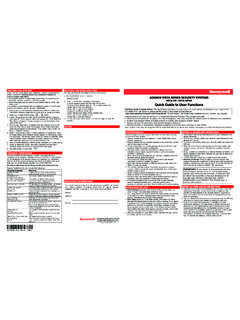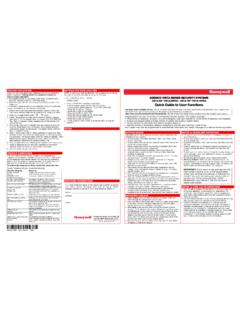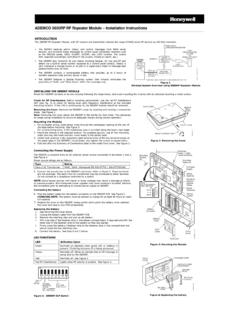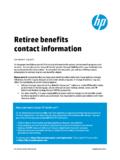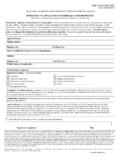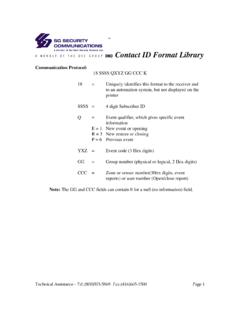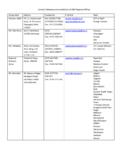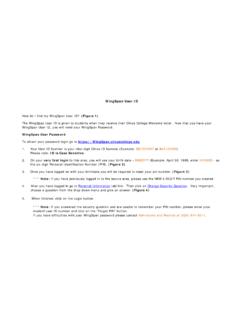Transcription of ADEMCO CONTACT ID REPORTING - …
1 ADEMCO CONTACT ID REPORTING . (revised 10/1/2012). CONTACT ID REPORTING takes the following format: CCCC Q EEE GG ZZZ. CCCC = customer (subscriber account number). Q = event qualifier, E = new event, R = restore EEE = event code GG = partition number, 00-08 (always 00 for non-partitioned panels). ZZZ = zone ID number REPORTING the alarm (001-099), or user number for open/close reports. * System status messages ( AC Loss, Low Battery) contain zeros in the ZZZ location. EVENT QUALIFIER. SUBSCRIBER ID # Event or Restore or EVENT CODE* PARTITION # ZONE OR USER #. Previous XXXX E or R or P* 000 00 C000 or U000. *Previous Event REPORTING - (Some panels have this feature) If there is a phone line (or radio) failure and the panel has exhausted its maximum EVENT CODE CLASSIFICATIONS: attempts to send REPORTING events to the central station, the panel will hold the messages in a buffer and resend upon restoral of the communication path AND a NEW event is generated.
2 In addition, when CONTACT ID is used, old messages that are sent will indicate that they are not current messages so that the central station does not dispatch on Medical: them. In order to accomplish this, an event qualifier of 6' (P) will be sent 100 Medical Emerg-Personal Emergency-# in place of the 1' (E) or 3' (R) character in the message. The P indicates 101 Pendant Transmitter Emerg-Personal Emergency-# that the message is old. Other formats will not indicate that the message is old. Events will be sent in chronological order and will be time- 102 Fail to report in Emerg-Fail to check in-# stamped in the system's event log. If the Dialer queue is full, the panel will replace old events with new events. FIRE ALARMS: 110 FIRE Fire-Fire Alarm-#. 111 SMOKE Fire-Fire Alarm-#. w/VERIFICATION. 112 Combustion Fire-Combustion-#.
3 113 WATERFLOW Fire-Water Flow -#. 114 Heat Fire-Heat Sensor-#. 115 Pull Station Fire-Pull Station-#. 116 Duct Fire-Duct Sensor-#. 117 Flame Fire-Flame Sensor-#. 118 Near Alarm Fire-Near Alarm -#. PANIC ALARMS: 120 Panic Alarm Panic-Panic-#. 121 DURESS Panic-Duress- User 000, or duress zone number on low end panels 122 SILENT Panic-Silent Panic-#. 123 AUDIBLE Panic-Audible Panic-#. 124 Duress-Access Granted Panic-Duress Access Grant-#. 125 Duress-Egress Granted Panic-Duress Egress Grant-#. BURGLAR ALARMS: 130 Burglary Burg-Burglary-#. 131 PERIMETER Burg-Perimeter-#. 132 INTERIOR Burg-Interior-#. 133 24 HR BURG (AUX) Burg-24 Hour-#. 134 ENTRY/EXIT Burg-Entry/Exit-#. 135 DAY/NIGHT Burg-Day/Night-#. 136 Outdoor Burg-Outdoor-#. 1. 137 TAMPER Burg-Tamper-#. 138 Near Alarm Burg-Near Alarm-#. 139 Intrusion Verifier Burg-Intrusion Verifier-#.
4 GENERAL ALARMS: 140 General Alarm Alarm-General Alarm-#. 141 Polling Loop Open Alarm-Polling Loop Open 142 POLLING LOOP SHORT (AL) Alarm-Polling Loop Short 143 EXPANSION MOD FAILURE Alarm-Exp. Module Tamper-#. 144 Sensor Tamper Alarm-Sensor Tamper-#. 145 Expansion Module Tamper Alarm-Exp. Module Tamper-#. 146 SILENT BURG Burg-Silent Burglary-#. 147 Sensor Supervision Trouble Sensor Super. -#. 24 HOUR NON-BURGLARY: 150 24 HOUR (AUXILIARY) Alarm-24 Hr. Non-Burg-#. 151 Gas Detected Alarm-Gas Detected-#. 152 Refrigeration Alarm-Refrigeration-#. 153 Loss of Heat Alarm-Heating System-#. 154 Water Leakage Alarm-Water Leakage-#. 155 Foil Break Trouble-Foil Break-#. 156 Day Trouble Trouble-Day Zone-#. 157 Low Bottled Gas Level Alarm-Low Gas Level-#. 158 High Temp Alarm-High Temperature-#. 159 Low Temp Alarm-Low Temperature-#. 161 Loss of Air Flow Alarm-Air Flow-#.
5 162 Carbon Monoxide Detected Alarm-Carbon Monoxide-#. 163 Tank Level Trouble-Tank Level-#. 168 High Humidity Trouble-High Humidity-#. 169 Low Humidity Trouble-Low Humidity-#. FIRE SUPERVISORY: 200 FIRE SUPERVISORY Supervisory-#. 201 Low Water Pressure Super-Low Water Pressure-#. 202 Low CO2 CO2-#. 203 Gate Valve Sensor Valve-#. 204 Low Water Level Water Level-#. 205 Pump Activated Activation-#. 206 Pump Failure Failure-#. SYSTEM TROUBLES: 300 System Trouble Trouble-System Trouble 301 AC LOSS Trouble-AC Power 302 LOW SYSTEM BATT Trouble-Low Battery (AC is lost, battery is getting low). 303 RAM Checksum Bad Trouble-Bad RAM Checksum (Restore Not Applicable). 304 ROM Checksum Bad Trouble-Bad ROM Checksum (Restore Not Applicable). 305 SYSTEM RESET Trouble-System Reset (Restore Not Applicable). 306 PANEL PROG CHANGE Trouble-Programming Changed (Restore Not Applicable).
6 307 Self-Test Failure Trouble-Self Test Failure 308 System Shutdown Trouble-System Shutdown 309 Battery Test Fail Trouble-Battery Test Failure (Battery failed at test interval). 310 GROUND FAULT Trouble-Ground Fault-#. 311 Battery Missing Trouble-Battery Missing 312 Power Supply Overcurent Trouble-Pwr. Supp. #. 313 Engineer Reset Status-Engineer Reset User # (Restore Not Applicable). 314 Primary Power Supply Failure Trouble Pri Pwr Supply Fail - # (Sent by UL864 Rev 9 Fire panels like FBP). 316 System Tamper Trouble APL System trouble - #. 2. SOUNDER/RELAY TROUBLES: 320 SOUNDER / RELAY Trouble-Sounder/Relay-#. 321 BELL 1 Trouble-Bell/Siren #1 (Event an Restore). 322 BELL 2 Trouble-Bell/Siren #2 (Event an Restore). 323 Alarm Relay Trouble-Alarm Relay 324 Trouble Relay Trouble-Trouble Relay 325 Reversing Relay Trouble-Reversing Relay 326 Notification Appliance Ckt.
7 # 3 Trouble-Notification Appl. Ckt#3. 327 Notification Appliance Ckt. # 4 Trouble-Notification Appl. Ckt#4. SYSTEM PERIPHERAL TROUBLES: R330 System Peripheral (E355) Trouble-Sys. Peripheral-# From LRR, ECP data connection to panel. 331 Polling Loop Open Trouble-Polling Loop Open 332 POLLING LOOP SHORT Trouble-Polling Loop Short 333 Exp. Module Failure (353) Trouble-Exp. Module Fail-# ECP Path problem between panel to LRR, etc (new). 334 Repeater Failure Trouble-Repeater Failure-#. 335 Local Printer Paper Out Trouble-Printer Paper Out 336 Local Printer Failure Trouble-Local Printer 337 EXP. MOD. DC LOSS Trouble-Exp. Mod. DC Loss-#. 338 EXP. MOD. LOW BAT Trouble-Exp. Mod. Low Batt-#. 339 EXP. MOD. RESET Trouble-Exp. Mod. Reset-#. 341 EXP. MOD. TAMPER Trouble-Exp. Mod. Tamper-# (5881 ENHC). 342 Exp. Module AC Loss Trouble-Exp. Module AC Loss-#.
8 343 Exp. Module Self Test Fail Trouble-Exp. Self-Test Fail-#. 344 RF Rcvr Jam Detect # Trouble-RF Rcvr Jam Detect-#. 345 AES Encryption disabled/enabled Trouble-AES Encryption COMMUNICATION TROUBLES: 350 Communication Trouble-Communication Failure 351 TELCO 1 FAULT Trouble-Phone line # 1 Comes in as zone 1 on a V20P panel 352 TELCO 2 FAULT Trouble-Phone Line # 2. 353 LR Radion Xmitter Fault (333) Trouble-Radio Transmitter Comm Path problem between panel and lrr (0ld). 354 FAILURE TO COMMUNICATE Trouble-Fail to Communicate E355 Loss of Radio Super. (R330) Trouble-Radio Supervision From LRR - ECP data connection to panel 356 Loss of Central Polling Trouble-Central Radion Polling 357 LRR XMTR. VSWR Trouble-Radio Xmitter. VSWR-#. PROTECTION LOOP: 370 Protection Loop Trouble-Protection Loop-#. Note: Uplink cell backup devices send zone 99 for a low battery and a zone 97 for communication failure (no response from poll).
9 These will report as CONTACT ID E370 (protection loop). let me clarify this: these are signals GENERATED by the uplink to indicate STATUS of the uplink. Of course, central station will assume that they were generated by the panel. Additional codes that may be sent would be for zones 81-86. which correspond to hardwire inputs 1-6. The CONTACT ID message for these is selected by uplink when it is programmed. 371 Protection Loop Open Trouble-Prot. Loop Open-#. 372 Protection Loop Short Trouble-Prot. Loop Short-#. 373 FIRE TROUBLE Trouble-Fire Loop-# (Supervision Loss,base tamper, Supervisory open). 374 EXIT ERROR (BY USER) Alarm-Exit Error-#. 375 Panic Zone Trouble Trouble-PA Trouble-#. 376 Hold-Up Zone Trouble Trouble-Hold-Up Trouble-#. 377 Swinger Trouble Trouble Swinger Trouble-#. 378 Cross-zone Trouble Trouble Cross Zone Trouble - # (restore not applicable).
10 SENSOR: 380 SENSOR TRBL - GLOBAL Trouble-Sensor Trouble-# (zone type 5 and 19). 381 LOSS OF SUPERVISION Trouble-RF Sensor #. 382 LOSS OF SUPRVSN Trouble-RPM Sensor #. 383 SENSOR TAMPER Trouble-Sensor Tamper-# (Cover or Base). 384 RF LOW BATTERY Trouble-RF Sensor Battery-#. 385 SMOKE HI SENS. Trouble-Smoke Hi #. 3. 386 SMOKE LO SENS. Trouble-Smoke Lo #. -387 INTRUSION HI SENS. Trouble-Intrusion Hi #. -388 INTRUSION LO SENS. Trouble-Intrusion Lo # - These codes are similar to those used for smart smoke detectors. The idea is to report a problem developing in the detector's operation. 389 DET. SELF TEST FAIL Trouble-Sensor Test Fail-# (see Direct Wire #84). 391 Sensor Watch Failure Trouble-Sensor Watch Fail-#. 392 Drift Comp. Error Trouble-Drift Comp. Error-# - Reported by Firelite panels. The panel is not able to adjust its thresholds to balance out drift in the normal operating point of a smoke detetctor.
